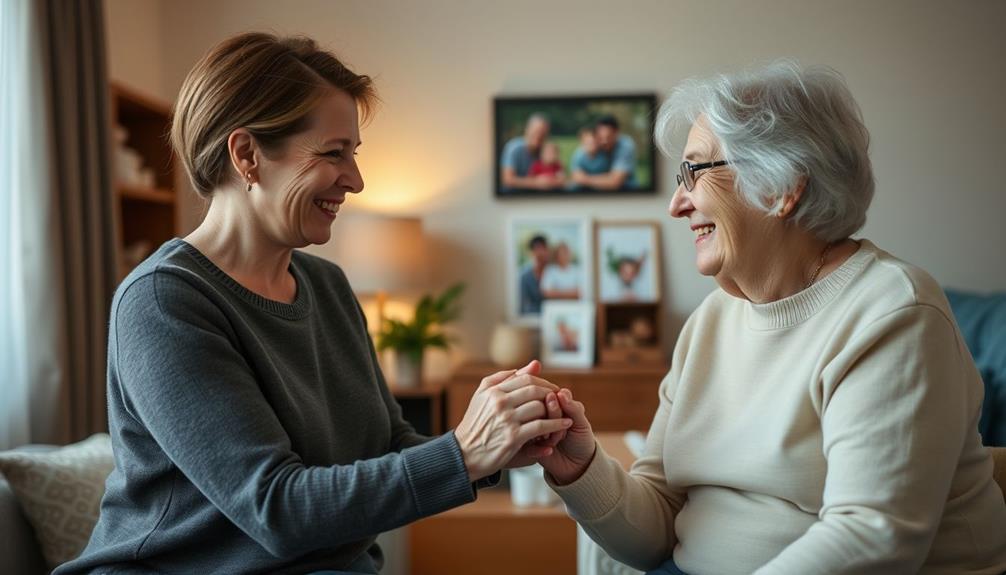When caring for individuals with dementia, it is important to prioritize clear and straightforward communication. Stick to topics that are familiar and maintain a calm setting to minimize distractions. As verbal abilities diminish, nonverbal cues such as facial expressions and gestures play a crucial role. Practice patience and allow sufficient time for responses, while actively listening to validate their emotions. Using a gentle tone during conversations can help create a comforting atmosphere. Familiar environments and sensory stimuli can enhance the emotional bond as well. Adapting your approach as dementia progresses can greatly enhance your interactions. There is a wealth of knowledge to explore regarding effective strategies and techniques for improved communication.
Key Takeaways
- Use simple language and short sentences to enhance understanding and reduce confusion during conversations with dementia patients.
- Actively listen and allow ample time for responses to validate feelings and foster a connection.
- Maintain eye contact and utilize nonverbal cues like gestures and facial expressions to improve emotional engagement.
- Create a calm, distraction-free environment to facilitate better communication and reduce anxiety during interactions.
- Incorporate familiar topics and personal memories to stimulate cognitive engagement and reinforce the individual's identity.
Understanding Dementia and Communication

When you immerse yourself in the world of dementia, it's essential to grasp how this progressive condition affects communication. Dementia markedly impairs a person's ability to communicate, leading to challenges like word retrieval difficulties and incoherent speech. As you interact, you'll notice that emotional responses may heighten, and confusion can set in, making effective communication even more important.
Understanding the key domains of development can provide insight into how cognitive decline impacts communication abilities.
Nonverbal communication becomes increasingly important as verbal abilities decline. Pay attention to body language and facial expressions; they often convey feelings and thoughts that words can't. By focusing on these cues, you can better understand the individual's emotions and needs.
Active listening plays a significant role in these interactions. It allows you to validate feelings, showing the person that you care and are engaged.
To enhance communication, engage individuals with dementia in familiar topics and use simple, clear language. This approach helps maintain connections and encourages them to express themselves.
Communication Challenges in Dementia

When you communicate with someone who's dementia, you might notice unique difficulties that can complicate your conversations. Their emotional responses can heighten, leading to frustration and misunderstandings, which makes patience essential.
It's important to remember that expressions of love and support, similar to heartfelt expressions of love, can help ease communication barriers.
Recognizing these challenges can help you adapt your approach and foster more meaningful interactions.
Unique Communication Difficulties
Unique Communication Difficulties (Communication Challenges in Dementia)
Dementia presents unique communication difficulties that can be challenging for both patients and caregivers. A person with dementia often experiences difficulty finding the right words during conversations, which can lead to frustration. They may resort to using related terms or even make up words, making communication less clear.
As the disease progresses, incoherent speech and an inability to comprehend full conversations become more common, creating significant barriers. This situation can be exacerbated by emotional dysregulation, similar to what's observed in individuals with Borderline Personality Disorder, where intense emotional responses can complicate interactions.
Additionally, many individuals with dementia struggle with reading and writing, limiting their ability to engage in written communication or understand text. You might notice that they frequently interrupt or disregard social cues, not recognizing when it's appropriate to speak or listen. This can disrupt the flow of conversation and leave you feeling uncertain about how to engage.
It's important to be prepared for these challenges. Understanding the feelings behind their communication difficulties can help foster patience and compassion.
Emotional Responses and Frustration
Communication difficulties often lead to heightened emotional responses in individuals with dementia, resulting in frustration for both them and their caregivers. When you try to communicate with a person suffering from dementia, misunderstandings can quickly escalate feelings of agitation. Common triggers include trouble finding words, following complex conversations, or feeling ignored.
To navigate these emotional challenges effectively, focus on non-verbal communication. Gestures, facial expressions, and body language can convey emotions and intentions when verbal skills decline. Practicing patience is key; allow ample time for responses and use supportive techniques to validate their feelings.
Here's a quick reference table to help you understand the emotional responses associated with communication challenges:
| Trigger | Emotional Response |
|---|---|
| Difficulty finding words | Frustration |
| Inability to follow conversations | Agitation |
| Feeling ignored | Sadness or anger |
Strategies for Early Stage Communication

Effective strategies for engaging with individuals in the early stages of dementia can considerably enhance their ability to communicate. You can help by including the person in conversations, actively listening, and allowing adequate time for them to express their thoughts. This patience fosters a positive communication environment and encourages them to share more.
Additionally, being aware of the potential challenges such as ear pressure during colds can help you better understand the person's experiences and how they may impact communication.
Utilizing their preferred communication methods is essential. Face-to-face interactions often yield the best results, but technology like email can also help maintain connections. Make sure the environment is calm and quiet, with good lighting to minimize distractions, allowing the person to focus better on the discussion.
Encourage regular social interaction and participation in familiar activities. These practices not only reinforce the person's identity but also support cognitive engagement, making it easier for them to participate in conversations.
Techniques for Middle Stage Interaction

As individuals progress into the middle stage of dementia, they often face heightened communication challenges that require thoughtful engagement. To foster effective communication, choose a quiet environment to minimize distractions. This helps you both focus on the conversation.
Use clear and slow speech while maintaining eye contact; this enhances understanding and builds a connection. Incorporating techniques like gentle stretching before bedtime can also help alleviate stress for both the caregiver and the individual, creating a calmer atmosphere.
Keep your questions short and simple. Complex questions can lead to confusion and frustration, so aim for direct inquiries that encourage the person to respond. Remember, patience is key.
Providing reassurance during conversations alleviates anxiety, supporting their emotional well-being as they navigate these communication hurdles.
Incorporating familiar topics or personal memories can stimulate cognitive engagement. Discussing shared experiences or cherished memories reinforces their identity and connection to you. This approach not only aids communication but also enriches their sense of self.
Ultimately, your goal is to create an environment that fosters open dialogue and emotional safety. By being mindful of your communication style and the person's environment, you can greatly improve interactions, making them more enjoyable and meaningful for both of you.
Approaches for Late Stage Engagement

In the late stages of dementia, focusing on nonverbal communication can make a significant difference in your interactions.
Utilizing elements from the power of imagination can help caregivers create a more engaging environment that encourages emotional expression.
Using gestures, facial expressions, and even touch can help create emotional connections that words often can't convey.
Nonverbal Communication Techniques
During the later stages of dementia, nonverbal communication techniques become essential for meaningful interaction. As verbal abilities decline, you might notice that individuals rely heavily on body language, gestures, and facial expressions to express their needs and emotions.
Approaching a person from the front while maintaining eye contact can help a person feel more secure and engaged, easing confusion or anxiety. Incorporating music therapy can enhance emotional well-being and create a calming atmosphere that encourages connection.
Touch and sensory cues are powerful tools. Holding hands or providing gentle physical contact can convey comfort and reassurance, fostering a deeper sense of connection. It's important to understand and interpret emotions through nonverbal signals—like smiles, frowns, or shifts in posture—so you can respond appropriately to their feelings.
Incorporating familiar music or engaging in sensory-stimulating activities can further enhance emotional responses, making it easier to connect nonverbally. These moments of joy can considerably improve the interaction, even when words fail.
Emotional Connection Strategies
Creating emotional connections with late-stage dementia patients requires a thoughtful approach that goes beyond words. You'll find that nonverbal communication plays an essential role in these interactions.
Here are some strategies to enhance emotional engagement:
- Utilize Tone of Voice: A soft, soothing tone can convey warmth and reassurance, helping to ease any anxiety they might feel.
- Incorporate Familiar Environments: Surrounding them with familiar items and minimizing distractions can create a comforting atmosphere, making them feel safe and secure.
- Engage Through Sensory Cues: Use familiar music or comforting scents to evoke positive emotions and memories. These sensory inputs can bridge the gap when words fail.
- Offer Companionship: Simply being present can greatly boost their emotional well-being. Your quiet companionship can help reduce feelings of isolation, making them feel valued and connected.
The Caregiver's Role in Communication

Caregivers are essential in bridging the communication gap with dementia patients, ensuring their voices are heard and understood. Your role involves utilizing effective strategies tailored to each person's unique communication abilities and preferences.
As dementia progresses, adapting your approach becomes important. Understanding the significance of managing behavioral issues can also enhance your interactions, allowing you to address potential challenges proactively.
Active listening is key; it allows you to respond thoughtfully and reinforce the emotional connection. Providing both verbal and non-verbal encouragement enhances understanding during interactions.
Training programs can sharpen your communication skills, equipping you to navigate the challenges presented by dementia-related difficulties more effectively.
Maintaining a calm and patient demeanor is essential. Allow ample time for responses, which reduces frustration for both you and the individual with dementia.
Consistency in your communication style is equally important; it minimizes confusion and creates a stable environment that fosters connection.
Resources for Support and Education

Accessing the right resources can greatly enhance your ability to communicate effectively with dementia patients. Utilizing tools like educational materials, support groups, and apps for dementia caregiving can provide both caregivers and family members with valuable strategies for engagement. These apps often offer reminders, cognitive exercises, and communication tips designed to cater to the specific needs of dementia patients. By leveraging such resources, caregivers can create more meaningful and supportive interactions while managing challenging behaviors.
As a caregiver, it's crucial to leverage available tools and education to improve your interactions. Understanding building codes and zoning laws can also empower you to create a supportive environment for your loved one.
Here are some valuable resources you can explore:
- Alzheimer's Association: They offer educational webinars and communication documents tailored for caregivers, helping you refine your skills.
- Local Alzheimer Society chapters: These provide support groups and advocacy efforts, fostering community understanding and resources related to dementia care.
- Professional training programs: Look for programs that focus on effective communication strategies to help you develop skills specific to your loved one's needs.
- Online platforms like ALZConnected: Join this community to share experiences, seek advice, and access valuable resources related to dementia care.
Frequently Asked Questions
What Are 6 Communication Techniques You Should Use When Communicating With a Person With Dementia?
When communicating, use clear language, maintain eye contact, and guarantee a calm tone. Incorporate non-verbal cues, allow time for responses, and engage in familiar topics to create a supportive and comfortable environment.
What Are the Communication Tools for Dementia Patients?
To enhance communication with dementia patients, use visual aids, simple language, and a calm tone. Incorporate familiar objects, practice active listening, and maintain eye contact to foster understanding and connection during interactions.
What Are Three Ways to Communicate Non-Verbally With Dementia?
Imagine a warm hug; it speaks volumes. You can communicate non-verbally by maintaining eye contact, using gentle touches, and showing expressive facial gestures. These methods create warmth, understanding, and connection, even when words fail.
How Do You Engage a Dementia Patient in a Conversation?
To engage a dementia patient in conversation, use simple language and familiar topics. Maintain eye contact and be patient, allowing time for responses. Non-verbal cues, like gestures, can also enhance understanding and connection.
Conclusion
In summary, effective communication with dementia patients is essential for enhancing their quality of life. Did you know that nearly 50% of people with dementia experience significant communication challenges that can lead to frustration and isolation? By employing tailored strategies for each stage of the disease, you can foster meaningful connections and provide necessary support. Remember, your role as a caregiver is significant in steering these conversations and ensuring that your loved one feels heard and understood.









